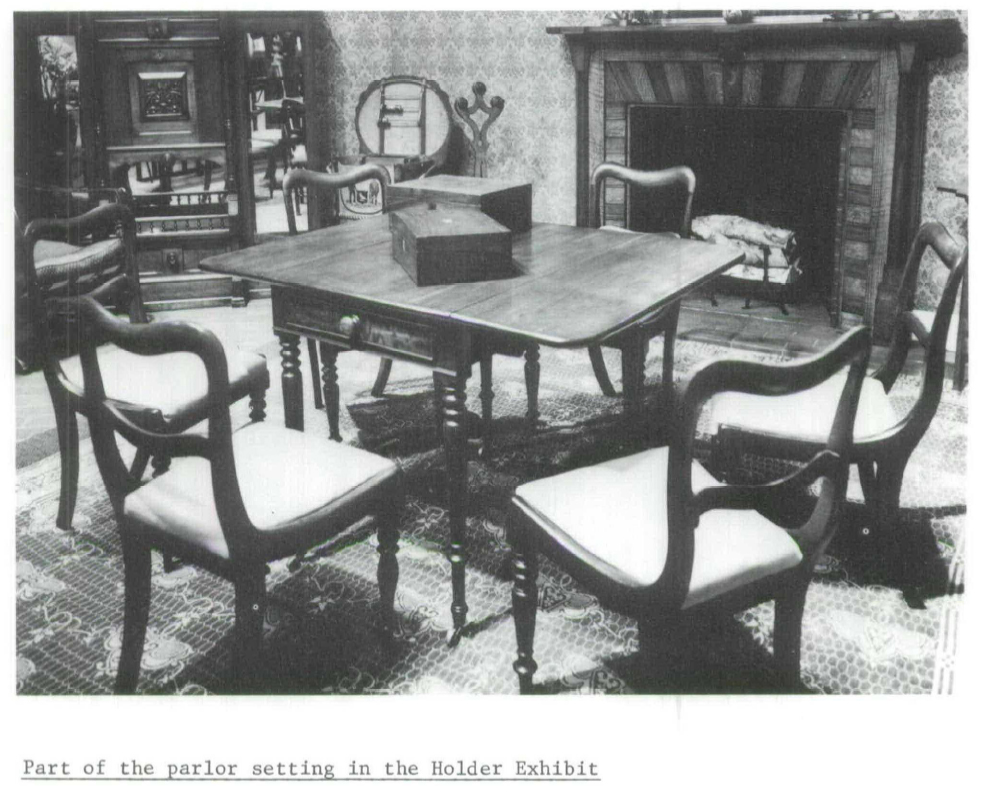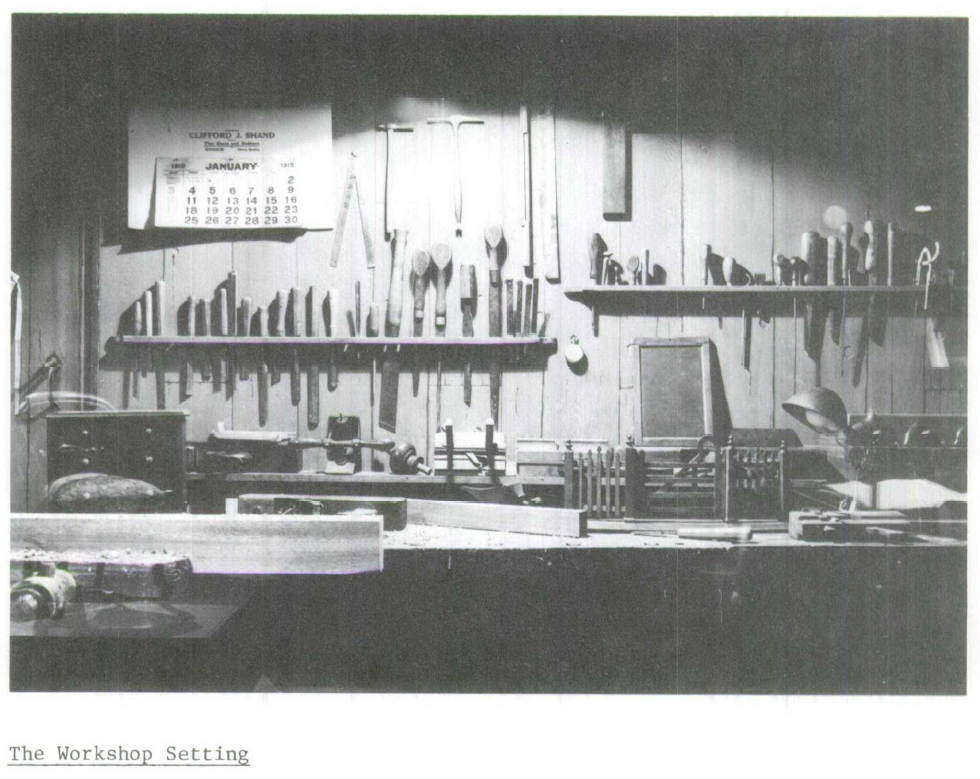Articles
Father and Son, Two Halifax Cabinetmakers:
Thomas C. Holder 1821-1894, Henry A. Holder 1853-1935
1 On 27 November 1975 forty descendants of Thomas Holder of Halifax came to a preview of the exhibit "Father and Son". They saw furniture, tools and documents displayed that relate to their own family history and this, in essence, is what the exhibit is about: it is a small family history.
2 The interest in preparing this exhibition lay in bringing together, from seven sources within the family, representative pieces of Holder furniture, almost one hundred of their tools, and a collection of family papers and documents. These family papers served to give a perspective of family history - and to cast light on the two craftsmen themselves, standing in the shadows of time.
3 The family narrative that emerged from a study of the documents refers first to a Thomas Holder "Volunteer first-class" on board H.M.S. "Charon" in 1801. He was then thirteen years old. The "Charon" is listed as a 44-gun vessel of the fleet employed in the Mediterranean and on the coast of Spain under Admiral Lord Keith in the year 1801 and, again, giving naval support to the landing of British troops taking part in the invasion of Egypt, off Alexandria.1 Thomas Holder's discharge papers, written from Valetta in 1803, commend his sobriety and obedience.
4 The second document exhibited is a Privateer's Licence, issued on 3 August 1813 to Thomas Holder, Master of the brig "Lord Collingwood" of Liverpool, England - "intended to be employed in the Mercantile trade from Great Britain to foreign parts". The vessel, however, was "armed with 12 guns, 12 pounders, 25 muskets, 25 cutlasses, 25 pikes and 26 pistols". There was a crew of 25 men and boys.
5 In 1828 this same Thomas Holder was appointed "Tide Surveyor of the Port of Halifax". A Tide Surveyor was an executive officer in charge of tide-waiters, who were customs officers working at dockside or on board ship. So the Holder family came to Halifax, Nova Scotia, and in 1829 bought a property in the north suburb of the town. Thomas Holder and his wife Elizabeth had a son, Thomas C., born on March 28, 1821. At the age of twelve Thomas was taken by his father to be indentured to Mr. Angus Fraser, a British and India dry goods merchant, who also dealt in ropes, twines and nets.2
6 Four years later, in 1837, Thomas C. was apprenticed to Mr. William Fraser for four years and three months "to learn the art, trade and mystery of a Cabinet maker and Upholsterer". Thomas C. Holder's two sets of apprenticeship papers, dated 1833 and 1837, are on exhibit. His father had died in 1836 and, under the terms of the indenture taken out with William Fraser, cabinetmaker, Thomas C. was to reside with his mother, the widow Elizabeth, who would "receive 10 shillings of lawful money of Nova Scotia every week of his apprenticeship". This ended on April 7, 1841; Thomas C. was then 20 years old.
The Furniture
7 The earliest piece of Holder furniture exhibited is a miniature pedestal table of mahogany, made by Thomas C. as an apprenticeship piece when he was sixteen, in 1837. The latest piece is a telephone table made ninety years later by his son in 1927. (Since the opening of the exhibition a chest of drawers has been located which was made by Henry, aged 16, as his apprenticeship piece.)
8 The furniture is mainly displayed within a room which reconstructs the parlor of the Holder family home. All the furniture in the room, including the mantelpiece, was made by the father and son. Of Thomas C. Holder's work there is a sofa and a small desk. The sofa is a late version of the "Grecian Squab" design shown in Sheraton's Cabinet Directory of 1803. The show-wood is mahogany with a birch frame under the upholstery. The legs are turned. The sofa is without coil springs and is stuffed with mingled black and white hair. On a mahogany Pembroke table is a small rosewood writing-box. The six chairs placed around the table are of a design reproduced in Loudon's Encyclopedia of 1833. This design anticipates the balloon-back. In one of the letters exhibited Henry A. describes this shape as "the swan" design. An upholstered balloon-back chair, one of a set of six, is also on display, and the same letter refers to this as "not of father's design, but of a pattern common for 30 years after 1860, known as balloon-back".
9 Also exhibited is a day-book, covering the period 1883-93 and containing a record of work done by Thomas C. when he was aged 62-72. This included bookcases, secretary bookcases, a counting-house desk, crutches, "work on cabin of the brigantine Hattie Louise" and canvas boats. Over two hundred pieces that he made and many more items that he repaired are listed. Woods used by T. C. Holder, according to his day-book, were walnut (most frequently mentioned), mahogany, pine, white wood, lance wood, oak, birch, maple, ash, lignum vitae, cherry wood and chestnut.
10 Henry Arthur Holder was born in 1853 at Brenton St., Halifax. Years later he made a drawing of "the house where I was born" and this is exhibited. Henry wrote a series of three letters, with accompanying illustrations, "etched in my boyhood's brain and now sketched in my second childhood". These he sent to H. Piers, Curator of the Provincial Museum (now the Nova Scotia Museum), in 1933. They are recollections of his boyhood in Halifax in the 1860's. Of the "house where I was born" he writes that it was "one of a number framed down the shore (i.e. the South Shore of Nova Scotia) and designed to be shipped 'Around the Horn' to San Francisco to house the 'forty-niners'. My father purchased one of these frames that were left over after the vessel had her full deck-load". He erected it on his lot on Brenton Street.
11 Henry A. was apprenticed to his father and worked with him until 1885, when he joined the staff of Her Majesty's Dockyard as a cabinetmaker and joiner. He took his discharge in 1905. He continued working with wood for many years and there are examples of work done when he was over 70 years old. Many pieces exhibited are by Henry A., including two mantelpieces, a secretary bookcase and side tables.
12 He was an early exponent of "re-cycled" materials. There is on display a sewing table that he made entirely of salvaged wood found on the shores of Halifax Harbour. The lid is made from a tea chest, hinged to a cheese box; the front legs are formed from barrel staves and the back legs are broomsticks "turned" out of all recognition. On the front he painted the arms of the City of Halifax and, with punning intent, I am sure, added the civic motto "E Mare Merces" - "Wealth from the Sea". In another cabinet, made as a gift for a bride named Edith, he used woods beginning with each letter of her name - elm, dogwood, ironwood, teak, holly - to form the handles. This same ability he exercised with words for he was a minor poet.
13 Exhibited objects made by Henry Holder include a bookcase, chairs and side tables. He worked effectively on a small scale too. There is an inlaid jewel-box which he described as "the work-box veneered with Mexican mahogany"; the cover is of "crutch sawed from the log where it branches, to give the greatest configuration of grain". There is also a miniature chair six inches high carved from a solid piece of apple-wood.
Tools
14 Part of the exhibit is a reconstruction of the Holders' workshop. From 1883 to 1890 they were listed in the Halifax Directory as "Holder and Son, Cabinetmakers". One of their trade cards is in the window. Almost a hundred tools that they used were available and they are displayed as in use on the workshop walls, on the large Holder workbench and in one of their own tool chests.
15 Many of their tools are stamped with their names and at least four appear to have been made by Henry. The tools are almost all from Sheffield, England. There is a matched set of four back-saws, their blades strengthened with brass and the saw edges much worn. Several handles of tools have been replaced. The metal name-stamps of both father and son are displayed. A few finished pieces sit on the workbench and a silver Holder watch is hanging on a nail.
16 One day in 1934, when he was 81, Henry Holder spent a last afternoon in the attic where his tools were stored, then went downstairs and wrote a poem, his "Panegyric - An Old Cabinetmaker Says Farewell to His Tools". The following year, 1935, Henry Arthur Holder died.
Part of the parlor setting in the Holder Exhibit
17 The six mahogany chairs with slip-in seats are a matched set although there are three variations in the turnings used in the front legs of the chairs. T.C. Holder called this the "swan-neck" chair design and used it until c. 1860, when he changed to the "balloon-back" design. In 1883, according to his day-book, he charged $3.25 for a chair-frame.
18 The mahogany Pembroke table has a central fixed leaf and two drop leaves, supported on pivot brackets. One drawer is accommodated in the end-skirt of the table and there is a matching false drawer in the other end. This table design came into use in the second half of the 18th century and T.C. Holder had begun his apprenticeship in 1837. The measurements of this table correspond with those given for Pembroke tables in Blackie's Cabinet-Makers' Assistant of which T.C. Holder had a copy, dated 1853. These tables were "not now so common in good houses as formerly" according to this book. They were used as breakfast tables and in T.C. Holder's day-book he records "making English breakfast-tables" in 1883 at $4.50 and $3.50 each. A lady's rosewood writing-box, made by T.C. Holder, is on the table. It has a brass inlaid shield on the lid and a brass key-plate. The interior has a baize-covered writing surface and a pen-drawer in which lies, appropriately, a faded rose.
19 In the background can be seen a secretary-bookcase. Thomas C. Holder's day-book for the period 1883-93 refers to making thirteen bookcases, some of which were secretary bookcases for which, in 1884, he charged $65.00. The secretary bookcase shown is of mahogany. The central unit has a fielded panel (containing a relief carving of conventionalized leaves) which forms the fall-front of the desk. The bookcase sections are mirror-backed, with the shelves removed. Small wood turnings are arranged to form a gallery on top.
Source: Nova Scotia Museum
The Workshop Setting
20 The workshop shows the work bench, of Swedish design, used by T.C. Holder and his son, and some of the tools exhibited. The completed objects set on the work-bench are a miniature mahogany chest of drawers c. 1885 and an oak pipe-rack designed as a small fence, both made by H.A. Holder. On the wall are sets of gouges and chisels of English manufacture, marked with the Holders' name-stamps. Handle replacements, made by Henry A. Holder, are octagonal. A replica of Henry Holder's work-apron hangs on the wall. He was photographed in his work-clothes beside his bench (a studio photograph which he signed "Mechanically yours") and his grand-daughter made a copy of this apron for the exhibit.
Source: Nova Scotia Museum

